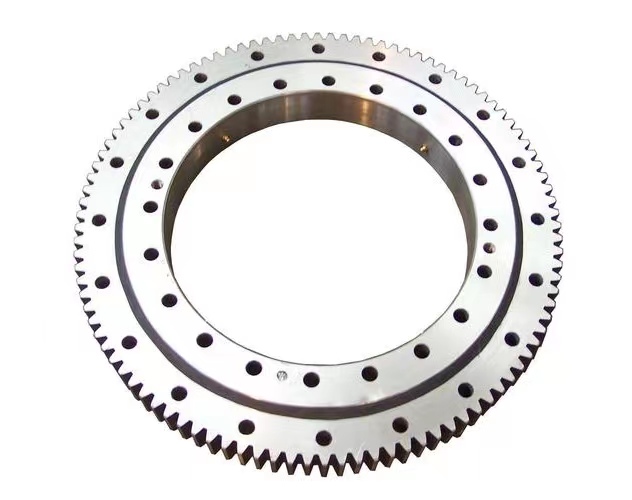Product FAQ
Basic knowledge of precision slewing bearings
Slewing bearings are a type of extra-large rolling bearings with a special structure that can simultaneously withstand combined loads such as axial load, radial load and overturning moment. They have high load capacity and integrate multiple functions such as support, rotation, transmission, and fixation. Compared with general rolling bearings, the biggest characteristic of slew bearings in terms of load-bearing mode is that they can withstand large eccentric loads (i.e. overturning moments). The load-bearing capacity has a great relationship with the eccentricity of the load. Most slewing bearings are structurally equipped with mounting holes, lubrication holes, and sealing devices. Therefore, slewing bearings have the characteristics of compact structure, simple installation, and easy maintenance.
Structure and characteristics
Four point contact ball bearings
Four-point contact ball slew bearings are mainly composed of inner rings, outer rings, single row steel balls, cages (or isolation blocks), sealing devices and other parts. The inner and outer rings of four-point contact ball slew bearings have integral and split structures. The rigidity of the integral ferrule is relatively strong, and the split type is easy to adjust. The split structure has two split rings connected together by bolts before the product leaves the factory. Four-point contact ball slew bearings usually have a cage (or isolation block). Only when the load is large, a full-fill ball structure is adopted. Full-fill ball four-point contact ball bearings have a large load-bearing capacity, but the friction resistance is large and the friction is easy. Causes scratches on the surface of the steel ball. The basic structure of four-point contact ball slew bearings:
No-tooth type (Type 010), external tooth type (Type 011/012), internal tooth type (Type 013/014)
Crossed cylindrical roller bearings
Crossed cylindrical roller slew bearings are mainly composed of inner rings, outer rings, single row rollers, cages (isolation blocks), sealing devices and other parts. The cylindrical rollers (axes) of the crossed cylindrical roller slew bearing are distributed crosswise on the raceway. The aspect ratio of the cylindrical rollers is less than 1, and the rollers slide slightly when moving. By adjusting the number of roller crossings and contact angle, it can cope with different combinations of axial force, overturning moment and radial force generated under various working conditions. The inner ring or outer ring of crossed cylindrical roller slew bearings can be divided into integral and split structures. In order to reduce the friction between rollers, they are usually designed with cages or isolation blocks. When the load is large, a full roller structure is used, but the friction resistance is large, and the friction can easily cause grooves along the circumferential direction in the contact parts between the rollers.
The basic structure of crossed cylindrical roller slew bearings:
No-tooth type (type 110), external tooth type (type 111/112), internal tooth type (type 113/114)
Toothless type (020 type), external tooth type (021 type/022 type), internal tooth type (023 type/024 type)

Categories
News
Contact Us
Contact: YRT Rotary Table Bearing|Crossed Roller Bearing|Luoyang Hongyuan Bearing 【HONB】
Phone: 13653797636
Tel: 400-037-9586
E-mail: lyhyzc7@gmail.com
Add: Chuangye road, Konggang Industrial cluster district,Luoyang city, Henan province, China